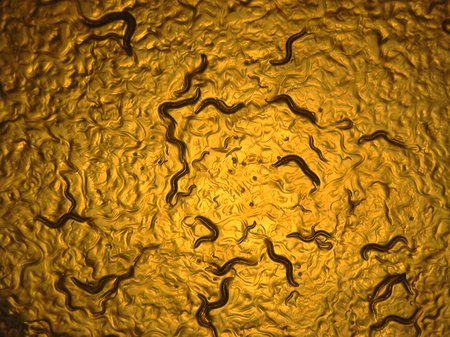Elephants, cats, flies, and even worms sleep. It is a natural part of many animals' lives. New research from Caltech takes a deeper look at sleep in the tiny roundworm Caenorhabditis elegans, or C. elegans, finding three chemicals that collectively work together to induce sleep. The study also shows that these chemicals—small proteins called neuropeptides that regulate neural activity—each control a different sleep behavior, such as the suppression of feeding or movement.
The results, accepted for publication in the journal Current Biology, suggest that other organisms, perhaps even humans, might similarly regulate individual components of sleep.
"The idea that multiple peptides work together to control sleep and its individual behaviors may translate to other animals," says Paul Sternberg, the Thomas Hunt Morgan Professor of Biology at Caltech and a Howard Hughes Medical Institute investigator. "C. elegans is a simple animal model that allows us to isolate key molecular pathways. We start there and the information trickles up to other animal models."
C. elegans, which is about the size of the comma in this sentence, can be induced to sleep by certain stressors, such as heat. Researchers have used this behavior to get at the root of what regulates the worm's sleep. The transparent organisms, which live for only a few weeks, can be easily observed through microscopes. In 2007, a former Caltech postdoc, Cheryl Van Buskirk, now at California State University, Northridge, discovered that one cell alone, known as the ALA neuron, is responsible for inducing sleep in C. elegans; if you remove that cell, the worms cannot fall asleep.
In the new study, Sternberg and his team isolated genes that encode various neuropeptides that are produced at high levels within this one sleep-inducing neuron. They discovered that knocking out three of the peptides (nlp-8, flp-24, and flp-13) in the worms prevented them from being able to sleep.
"Removing just three neuropeptide genes had the same result as taking out the entire ALA cell," says graduate student Ravi Nath, lead author of the new study.
When the researchers added the neuropeptides back, one by one, into insomniac worms, they discovered that certain sleep behaviors were restored. The peptide flp-13 suppressed feeding patterns; flp-13 and nlp-8 inhibited defecation; and flp-24 blocked movement in the worms.
"The different neuropeptides may act in parallel to control the sleep state," says Nath. "You can think of the peptides as workers building a house—or the state of sleep. One is like an electrician and the other a plumber, for example, working together as a team."
The researchers say there are still many questions left to pursue. They want to investigate to what extent the roles of these neuropeptides overlap with each other, and if they also have other purposes outside of regulating sleep.
The Current Biology study, titled, "C. elegans Stress-Induced Sleep Emerges from the Collective Action of Multiple Neuropeptides," was funded by the Howard Hughes Medical Institute, the National Institutes of Health, and the Della Martin Postdoctoral Fellowship. Other authors include Elly Chow and Han Wang of Caltech, and Erich Schwarz of Cornell University.
 Roundworms called C. elegans in a laboratory petri dish. The image was taken using a microscope; the worms are actually about 1 millimeter in length.
Credit: Sternberg Laboratory/Caltech
Roundworms called C. elegans in a laboratory petri dish. The image was taken using a microscope; the worms are actually about 1 millimeter in length.
Credit: Sternberg Laboratory/Caltech

